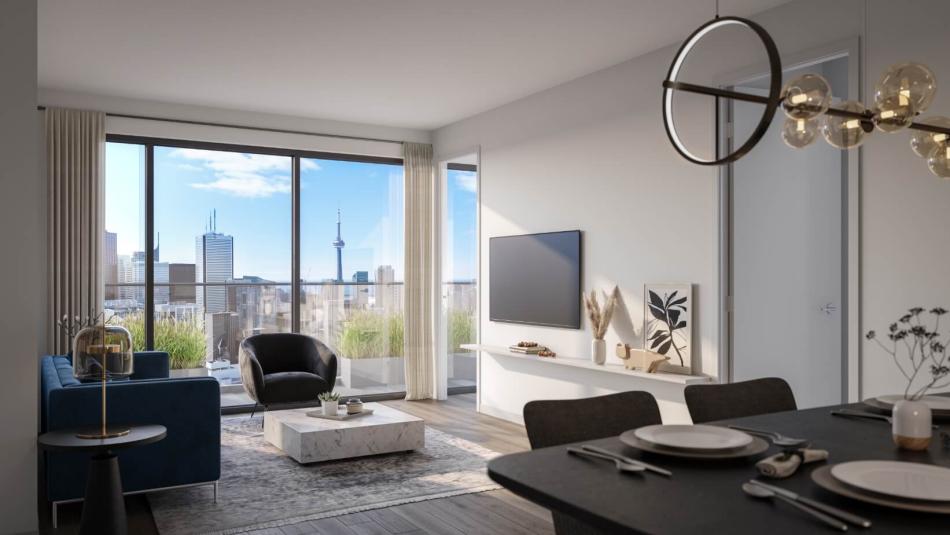As Toronto grapples with growing population and increasing costs of living, condominiums have become a more common and growing segment in the city’s booming real estate market. From a low-maintenance lifestyle, to convenient building and neighbourhood amenities, condominiums provide a unique urban living experience, however can result in smaller spaces.
Urbanize Toronto recently sat down with Linda Mitchell Young, a consultant with over four decades of experience having worked on more than 100 condominium developments across Toronto and the Greater Toronto Area (GTA). Renowned for her strategic acumen, she specializes in providing consultative services that extend beyond conventional practices through her firm, Linda Mitchell Marketing Inc. Linda’s pivotal role involves collaborating closely with developers, offering invaluable guidance to architects in structuring and optimizing the layout of their developments. She meticulously advises on the suite mix, unit size, and ideal positioning within the building, ensuring a harmonious blend of functionality and aesthetic appeal.
Why are condominium units becoming smaller? How do developers determine suite layouts and configurations? What should you look for in a floorplan? Find out all the answers and more in our exclusive Q&A!
Q: Tell us about yourself:
A: I’m Linda Mitchell Young, I’m a consultant with my company Linda Mitchell Marketing Inc. I consult for developers when they're trying to demise pre-construction buildings at the very initial stages — which involves creating the right suite type and optimal sizes. This includes deciding on the number of 1, 2, and 3-bedrooms and where they should go on the floor in a building. After we get that all sorted out, I do all the suite layouts and make sure that, even though the suites are getting smaller, we try and make them as efficient as possible, with no wasted space.
Q: What is demising, and what can happen when a developer skips this important process?
A: Typically when a developer buys a piece of land, there are a number of site specific requirements, bylaws, zoning, etc. that provide guidelines on things such as building height and the number of suites allowed. Once they sort out with the architect what the size of one floor would be, developers look for 85% efficiency — 15% of it they'll never be able to sell, including corridors, elevators, garbage chutes, stairs, and electrical closets.
But what happens? Sometimes developers look at it and say, ‘Okay, great, we got the 85% efficiency, we're good to go’.
When I take a look at it, I notice that even though it is 85% efficiency, the largest suite is facing into the building beside it, and the smallest unit is in the most optimal orientation as far as a premium view perspective. At that point, I suggest we look at potential re-demising.
The word demising can mean to orient the suites so that they're in the right location, so the biggest units are in the best location, because anybody that's going to spend the most money on a big suite wants to have the best view possible. We also demise it in a way that we have the right number of studios, 1-bedroom, 2-bedroom, and 3-bedroom units.
During the demising process, we must also make sure that the sizes are optimal. It is much more efficient to build larger suites and more cost effective based on less bathrooms, kitchens, etc., however, suite sizes are based on an end selling price that is attainable for buyers. Unfortunately the average price of a 1,000ft² suite in the city is approximately $1.7 million, which is not attainable by the average buyer.
Q: Tell us about your process when designing suite layouts
A: When I'm developing suite layouts, especially when spaces are smaller, I try to make sure the square footage goes in the rooms that are most used. Instead of hallways or large foyers, the space goes into the living and bedroom areas. I will always try to create as many storage opportunities as possible. There are a number of minimum room size requirements that are dictated by the City and must be adhered to. It's all about making the suite as efficient as possible in order for it to become as attainable as possible for a broader number of buyers.
In earlier days, when prices were lower, we were able to develop large spaces including large foyers and hallways, however with today's pricing, it has been necessary to remove these spaces.
Q: What are some of the biggest structural or design challenges when optimizing unit layouts today?
A: I’ve worked with a lot of the architects in the city over the years and I always suggest we design the building from the inside out.
If you want to design an architectural landmark with angles and curves, then you've got to design these small suites where you’re losing the living room because of this weird angled wall or curved wall. So I would say, ‘Let's design from the inside out, let's make it as kind of a square, or rectangular if possible, so the walls are all straight. And then on the outside, you can design something interesting with the balconies’, for example.
One of the most interesting buildings I worked on was Forma, a project by Dream, Great Gulf and Westdale, designed by Frank Gehry, a world renowned architect. It was not an option to instruct Mr Gehry to design his building from the inside out. Forma will be an architectural landmark for the City of Toronto and even though the suites were difficult to design, the building will be an icon in the City.
With a mid-rise building, each floorplan is different. There is no efficiency of scale like with a tower, where you can repeat the same suite types all the way up the building. They are certainly and are quite often sold at a premium, as people want to be in shorter, more intimate buildings with less number of units.
Q: What should condominium buyers look for in a floorplan?
A: I would begin with suggesting that buyers lower their expectations. Larger suites have become unattainable over the last few years so you may end up with a suite that is smaller than what you would like. I would look for a floorplan that doesn't have any wasted space. You can't afford to waste space anymore in these size units with the today’s pricing. And if you want to buy a larger unit, make sure that you've got a good view so that you're not paying for a big unit and then facing into another building.
If you are an investor buying, for example, a 1-bedroom suite to rent out, I would suggest one of the smaller suites without any premiums associated to it, as these premiums would be difficult to recover.
Q: Where are unit floorpans in Toronto headed, what other trends do you see coming in the future?
A: I do think that some of the product that we're designing now is for the ‘roommate scenario’. I always love to reference the show Friends — they were all roommates in order to afford living in Manhattan.
We've never thought about having to have roommates because we could always afford our own place, but now even in 3-bedrooms units we’re designing, we've been looking at including 3-bathrooms which would accommodate three people splitting the rent, as opposed to renting a 1-bedroom on their own. If you're renting out a 1-bedroom unit right now in Toronto, you're paying about $2500-2600/month, if you rent out a 2-bedroom you're paying $3600/month. So two people sharing a 2-bedroom, 2-bathroom unit pay $1800/month each.
Not everyone's going to love having a roommate, but you could save money by doing that. So I see the design of the units are starting to go that way so that we can do them where there's more of a roommate opportunity. All of these things evolve as pricing and affordability goes away like every other major city. We're certainly not as expensive as Manhattan, Hong Kong or many other major cities in the world, but we're getting there.
Q: Anything else you’d like to share?
A: I live in a condo in Downtown Toronto. Even though the unit sizes are smaller, I find that the bigger the space you have, the more stuff you collect. I would rather compromise space and have access by walking everywhere downtown, than a commute — it depends on a person's lifestyle, but it isn't as bad as people think.
Living in a small space you learn how to live in that space, how to become efficient, and just enjoy the lifestyle. Competition and the number of condos completed over the last several years has meant what used to be upgrades now comes standard, including 9 foot smooth ceilings, quartz countertops, stainless steel appliances, laminate flooring, porcelain flooring, and more. There are some really great finishes and it's a beautiful unit that you'd be living in. It's pretty surprising how efficient you can be in and the size of the unit you live in.
Toronto's got so much to offer and I think condominium living is a great way to go. It’s an easy lifestyle, no maintenance, no cutting grass, no shovelling snow, and that’s a good thing. The building amenities are also a great extension of your living space. Most buildings offer party rooms, great fitness areas, co-working spaces, rooftop lounges and pet washing stations.
About Linda Mitchell Young | Linda Mitchell Marketing Inc.
With over four decades of dedicated experience, Linda Mitchell Young has been a stalwart force in the realm of condominium real estate development across Toronto and the Greater Toronto Area (GTA). Renowned for her strategic acumen, she specializes in providing consultative services that extend beyond conventional practices through her firm, Linda Mitchell Marketing Inc.
Linda’s pivotal role involves collaborating closely with developers, offering invaluable guidance to architects in structuring and optimizing the layout of their developments. She meticulously advises on the suite mix, unit size, and ideal positioning within the building, ensuring a harmonious blend of functionality and aesthetic appeal. Linda’s expertise extends to suggesting bespoke designs for each suite, contributing to a comprehensive and tailored approach in real estate development.
Her visionary insights and deep industry knowledge have played a pivotal role in catapulting some of the city’s most successful and celebrated residential properties to the forefront. Linda Mitchell Young’s impact resonates not only in individual developments but also in the realization of master-planned communities that stand as testament to her unwavering commitment to excellence in the dynamic landscape of real estate.
Visit Linda’s website at http://www.lindamitchellmarketing.com











